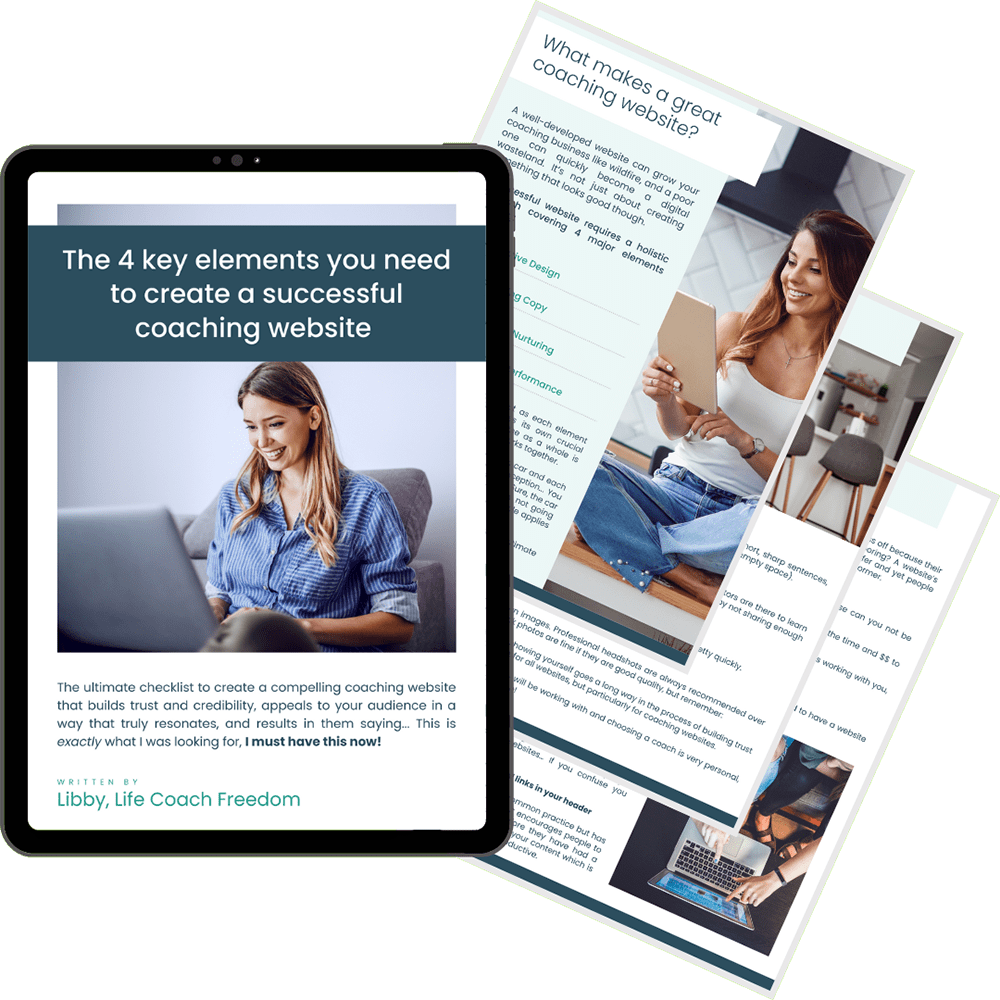

Your ideal customer is the cornerstone of your marketing efforts, and the level of success you achieve largely depends on how well-defined it is. Surprisingly, many coaches overlook the significance of completing this crucial task for their business.
The avoidance of creating an ideal customer profile can stem from various factors, but the most common reason is fear. Fear that if you focus on a smaller group of customers, it will restrict your business.
However, your profile is not supposed to be exclusive. But rather, it should act as a lens to focus your offerings and messaging to those that would best suit your business. Think of it as the heart of your niche.
This is crucial because when your marketing is communicated to a broad audience, it loses its impact, becoming generic and uninspiring, and failing to address the specific problems your ideal customer has.
Moreover, it neglects to speak directly to the psychological drivers that influence their buying decisions. Essentially, this results in a lack of empathy, connection and subsequently, lost sales.
In this article, we will delve into the significance of creating an ideal customer profile and provide actionable steps to do so. By defining a detailed ideal customer, you’ll unlock the potential to supercharge your results and achieve greater success in your coaching business.
Let’s get started!

An Ideal Customer Profile (AKA ideal customer Avatar, perfect customer, buyer persona etc.) is a semi-fictional character that is based on the customers who gain the most value from your product or service.
You create one by gathering both demographic and psychographic data:
This information helps you to understand your ideal customers better and aim for them specifically, rather than taking a hit & miss approach with a generalised audience.
Knowing your ideal customer allows you to hone your marketing to high-quality leads. Then, create messaging that resonates with them in the most compelling way possible, persuading them to buy.
This is by no means manipulative or salesly. You’re simply helping your perfect customers to gain their desired outcomes because what you’re selling is exactly what they need…
And just like that, your sales cycle becomes simple, smooth, and much more likely to have a positive result (for you and your customer!).
Conversely, creating a customer avatar also limits or even polarises customers who may not be your ideal ones. As harsh as that may sound, it’s just as important.
If you don’t refine your marketing wisely, there’s a possibility that people who are not your ideal customer could buy from you. You may find it hard or even unpleasant working with them, simply because they’re not the right fit.
Plus, because they’re not the right fit and what you offer is not quite right for them, a positive outcome is less likely… no one wins.
Essentially, the more you can refine your ideal customer profile, the better you’ll understand what they want, how to reach them, how to get them to buy, and most importantly, how to give them massive value and the outcome they desire.
Plus, your advertising campaigns will be tailored to the exact type of customers you want to work with because it gives you the most fulfilment… Everybody wins!

Defining a customer avatar for your coaching business offers several key benefits:
By clearly understanding the characteristics, preferences, and pain points of your ideal customer, you can create targeted advertising campaigns. This ensures that your messaging resonates with the right people, increasing the chances of attracting new customers who are genuinely interested in your coaching service.
Knowing your customer avatar allows you to allocate your resources effectively. Instead of spreading your advertising campaigns across a broad audience, you can focus your efforts on the segments that are most likely to result in sales. This saves time, money, and effort, maximising the impact of your marketing activities.
A well-defined customer avatar enables you to tailor your coaching programs and services to suit their specific needs. You can develop specialised coaching approaches, methodologies, and content that directly address their challenges and goals. This enhances the relevance and value of your coaching, increasing customer satisfaction and loyalty.
Understanding your customer avatar helps you create stronger connections on a deeper level with your clients. By speaking directly to their pain points, aspirations, and values, you demonstrate empathy and understanding. This fosters trust, as clients perceive that you truly “get” them and their unique circumstances, leading to easier sales and more meaningful coaching relationships.
When you align your coaching approach with the needs and desires of your customer avatar, you can deliver more impactful and effective coaching sessions. By tailoring your strategies to their specific challenges, you increase the likelihood of providing value and achieving desired outcomes. Satisfied customers who see positive results are more likely to refer others and become brand advocates for your coaching business.
Defining your ideal customer profile allows you to differentiate yourself from competitors. By specialising in serving a specific target market, you position yourself as an expert in that industry. This specialisation sets you apart, making it easier for new prospects to choose you as their preferred coach.
So, are you ready to ditch the confusion & fear and confidently create marketing strategies that work? Let’s dive in and create your ideal customer profile!

It’s vital to do your research and gain accurate data, instead of just assuming you know your ideal customers inside-out already. Plus, gaining the perspective directly from your customers is incredibly insightful and well worth the time. You might get an answer that you had not considered before, or information you weren’t aware of.
There are a number of ways you can research to gather data, you can read reviews, talk to past or current customers, go through your analytics & company data to look for patterns, trends and commonalities, as well as reading through relevant forums & social media groups, and so on. Click here for more ideas.
If you’re just starting out and the above options aren’t possible for you right now, don’t put off doing it simply because you don’t have all the data yet. You can still benefit greatly from having a first draft of your ideal customer profile. You can always come back to it later to tweak any assumptions you do have to make.

Collecting demographic info allows you to paint a clear, more personal picture. For example, your messaging to a new mother would be completely different to an empty nester whose kids have just left home.
So, nail down the average person as though they are sitting right in front of you. The goal is, to make them as human as possible by gathering details including:
Frustrations are the tangible problems & challenges your avatar wants to move away from. Fears are what they have as a result of these tangible problems.
Let’s use a customer who wants to lose weight for example. They may be frustrated with diets that don’t work, the time consumption and they’re sick of empty promises. The resulting fears could be the feelings of shame and embarrassment of failing to lose weight.
When determining the fears of your own customers, the ultimate goal is to identify the emotional issues. By doing so, you will know what your highest priority should be to include in your messaging, and what will really resonate with them to build an emotional connection.

People are subconsciously driven to buy based on feelings more than things, so having an awareness of the emotions your ideal client may experience is vital.
Factors such as quality and expertise in your products & services are obviously important, but when we get right down to it, the psychology behind making a purchase decision is primarily driven by people wanting to avoid pain and gain pleasure.
For example, no one needs a Rolex watch. Sure, the quality is great, but a much more affordable brand will tell you the time just the same. So why do people buy them? Because of the pleasurable feelings owning a luxury product provides, such as feeling significant, important, or special.
It’s also important to be aware that people will generally do more to avoid pain than they will to gain pleasure. This is why creating awareness around your buyer’s pain points and then showing them how you can relieve that pain is essential.
As I mentioned previously, this isn’t manipulative, you’re simply providing a solution to a problem. Not unlike a doctor providing pain relief for a disease – they didn’t create the disease, they merely diagnosed it and prescribed a relevant treatment.
If you know what your ideal customer’s pain points are, this will help you to determine which emotions to target, to elicit the most impactful response.
Forbes also has a great article about Emotional connection the and role it plays in the choices we make as consumers.
Now it’s time to flip things to the positive and uncover the wants and desires of your ideal customers. As with their frustrations, this is not just the tangible things, but also how obtaining their wants will benefit them.
When you solve their problem, what does this mean for them long-term and what do they hope to feel or experience?
The goal here is to help you to identify the solution that will give your ideal customer the most pleasure.
Having identified both their pain points and desires, you can then integrate that information into your website copy (and all content marketing) in a way that addresses and empathises with their pain.
Then, demonstrate the solution to relieve it, and subsequently give them the pleasurable feeling or experience they desire.

The next step is to use the information we have gathered from steps 3 (fears/frustrations) and 4 (wants/desires) and collate it to identify your avatar’s experience before and after purchasing your services.
This will provide you with the info needed to easily articulate in your messaging the highly motivating transformations your coaching can deliver.
Before State: This is the negative, undesirable state they are in before buying your coaching service. E.g. what do they have right now that they don’t want and how that makes them feel?
After State: Now for the positive; the desirable state they are in after utilising your service. What do they have now and how does that make them feel?
What might stop your ideal customers from buying and conversely, what will motivate them to buy?
Having an awareness of buying objections so you can alleviate concerns upfront will demolish barriers before they even become a factor. On the flip side, if you also know what motivates your ideal customer to buy and highlight them, the combination of both will give you a huge advantage in your sales process.
There are common objections and motivators for all buyers, the goal with this step is to drill down to those that are really significant to your ideal customers.

Buying objections generally fall into 4 main categories; a lack of budget, trust, need, or urgency:
If your marketing is on point and you’re targeting your ideal customers, your buying objections should hopefully be minimal. There will almost always be some objections though, so it’s always important to address them.
Consider past leads (that were a good fit) where you didn’t make a sale, what stopped them?
As with the objections, if you’re also able to highlight factors that are motivators for your ideal customers, you’re conversions will subsequently improve. Some of the most common purchase drivers are convenience, accessibility, options, price, value, and trust.
As above, consider past leads but where you did make a sale, what factors got them over the line?
It’s clear that taking the time to identify your ideal customer is vital for coaches as it allows you to understand your target audience on a deeper level, tailor your coaching services accordingly, and create marketing strategies that work.
Moving forward, you can feel so much more confident in your ability to attract your best customers, provide massive value to them, and reach your sales goals.

You already have the tools above to get cracking on creating your ideal customer profile, but if want to expedite the process and uplevel your professionalism, my meticulously crafted Ideal Customer Profile Template is perfect for you.
Drawing on the experience and expertise of industry leaders, this template provides you with predefined fields to enter your customer data.
This not only makes building your ideal customer profile a lot faster (especially helpful if you’re creating multiple), but it also ensures consistency in your profiles, as well as allowing you to present them professionally and efficiently.
Get your hands on my Ideal Customer Profile Template now and unlock the secret sauce to targeted marketing and successful client conversion.
All the best!
Libby Hogan,
Digital Resource Specialist
Life Coach Freedom
If you’re passionate about coaching and hungry for valuable insights, expert tips, and the latest updates, look no further! Subscribe to our newsletter for exciting updates and subscriber-only discounts, promotions & resources.
"*" indicates required fields

Hi there, I'm Libby
The creative mind behind Life Coach Freedom
My ultimate goal is to help you ditch the drama around running your coaching business, enabling you to reach more clients and cultivate both a fulfilling & thriving practice. And in doing so, have a successful business that gives you the freedom to create the life you want.
I trust you will find the articles on this page useful, and if there’s a topic you would like to know more about, I would love to hear from you!

Free Download!
The 4 key elements you need to create a successful coaching website
"*" indicates required fields
Related Posts

Discover the 10 essential elements for crafting standout life coaching websites that not only attract visitors but convert them into clients.

Explore the significance of self-care for life coaches and learn how to implement actionable strategies to prevent burnout & achieve lasting success.

Discover the power of productivity tools in your coaching journey! Get organised, save time, simplify tasks, boost client interactions, and grow your business.

Life Coach Freedom offers done-for-you coaching tools, templates and niche websites to help you build a successful coaching business. Our ultimate goal is to save you time, money & energy so you have the freedom to create the life you want.
Handy Links